by Winding Pathways | Nov 24, 2022 | (Sub)Urban Homesteading, Birds, Bugs, Flowers/Grasses, Foraging, Garden/Yard, Nature
We think of fall as migration time when all the birds leave. And there is a great birdcast website to see in live time the flights. But an autumn walk through a park with wild edges reveals shrubs, bushes, and grasses alive with bird activity. Visit an orchard on a cold winter day and the odds are good for spotting robins pecking on frozen dropped apples, but wild fruits are more common, all just beyond suburbia.
Let’s step back to spring. When Rich worked at the Indian Creek Nature Center his phone would often ring during those first warm days. With excitement callers would announce that the robins had returned. Spring’s here!
Seeing a robin on a spring lawn gives the illusion that they’ve just made a long journey from a faraway wintering ground down south. Robins, bluebirds, and other birds usually just shift where they live and forage as seasons change.
Ecological Survivors
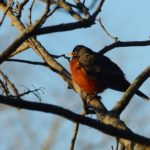
A robin surveys the area
Robins, in particular, are ecological survivors. They’re adapted to living on lawns and around people during the warm months, where they nest on porch eaves and forage for worms and bugs in mowed grass. The coming of fall’s cold marks the disappearance of robins from suburbia. They don’t go far and make an amazing dietary switcheroo to wild fruits.
Robins and bluebirds shun their summer buggy and wormy diet and shift to fruits and some seeds come winter.
On an October walk, we spotted several wild fruits – berries perhaps – that birds feast on during the cold months. the native plants are great – even the poison ivy – the exotics are problematic.
Here are some common winter weedy and seedy plants:
- Gray Dogwood. This small native dogwood often forms thickets along trails, parks, woods, and even yards and holds plenty of berries into cold months.
- Wild grapes. People rarely eat sour and seedy wild grapes, and sometimes birds also leave them alone during summer, but come winter the raison-like grapes make nutritious avian fare.
- Poke Weed. In late fall this tall purple-stemmed and fruited plant is hard to miss. Birds eat the frozen berries. Note: Poke berries are toxic to people and many mammals but not birds.
- Poison ivy. Gulp. This bane of allergic people is a beneficial wildlife plant. Deer and rabbits browse on the woody sprouts and birds feast on the berries.
- Asian Honeysuckle, Japanese Barberry, and Oriental bittersweet are “dirty bird plants.” Actually, birds love the berries and carry them far and wide to poop out the seeds. All three exotic plants are highly invasive and crowd out more desirable native plants. Birds have helped them conquer woodlands and field edges to the detriment of healthy bio-diversity.
-
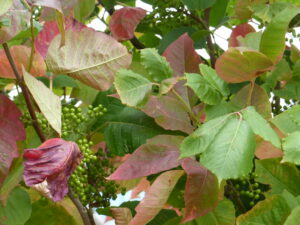
-
Poison Ivy berries are a favorite of birds.
-
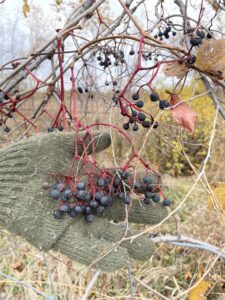
-
Wild grapes are a tasty winter treat.
-
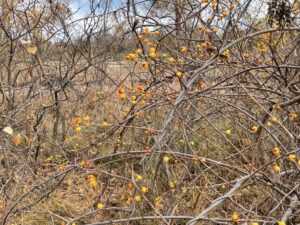
-
An invasive species and favorite of birds.
Winter Fare Is More Than Fruits
Winter bird fare isn’t just fruit. Many birds glean frozen spiders and insects from crevices in tree bark and dozens of species continue to eat grass and “weed” seeds. That’s a problem with mowed lawns. They produce no seeds, so few birds visit them during the colder months. Taller growing grasses, flowers, and shrubs often hold their seeds into the winter and are bird magnets.
-
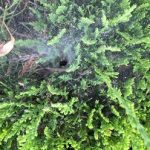
-
This beneficial spider controls insects in the yard.
-
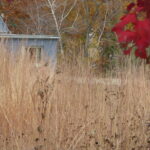
-
Birds bob on prairie grasses.
-
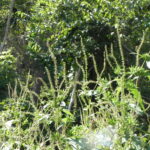
-
Ragweed seeds last through the winter.
Want to have birds in the yard all winter? Keeping feeders stocked helps, but better results come when homeowners encourage buffers of native shrubs, vines, and grasses that produce natural winter bird food and habitat. Most people love their tidy lawn, but edging the lawn, usually along a property line, or creating “pocket prairies” with native or desirable tall grasses, wildflowers, and shrubs adds summer color and year-round wildlife appeal. So, we encourage readers to create and leave wilder spaces for the birds!
by Winding Pathways | May 19, 2022 | (Sub)Urban Homesteading, Foraging, Garden/Yard, Weeds
Yes! The blossoms and leaves have vital nutrients and were cultivated by our European ancestors. In the modern world, every year homeowners spend money and elbow grease to poison their lawns all to try to rid their lawn of dandelions. They could sell the dandelions instead!
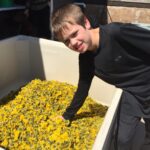
You can make money selling dandelion blossoms.
What? Sell dandelions? The Ackerman Winery in Amana, Iowa, crafts delicious dandelion wine. To make it they need thousands of the plant’s golden blooms and they pay $8 a gallon for them.
The dandelion season has faded for the 2022 spring, but we’ve seen lawns with many dollars’ worth of blooming dandelions that could have been sold. For information on how to buy dandelion wine or sell dandelions go on the Ackerman Winery website.
About Dandelions
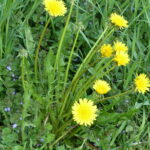
By mid-summer dandelion leaves are tough and bitter.
Dandelions are an amazing plant. Native to the Old World, their seeds were brought to America on the Mayflower. For thousands of years, people considered them a valuable resource. By late winter people often suffered from vitamin deficiency. Dandelion leaves are rich in vitamins and green up in early spring. People ate them to restore their health. They are as nutritious today as they were in the past.
Only in recent years have dandelions been considered pests. Because they are prolific, common, and easy to identify, chemical companies encouraged people to view dandelions as pests so they could sell herbicides.
How silly it is to spend money to kill plants that are good to eat and so nutritious. Thanks to Ackerman Winery they can even add to a family’s income.
How People Unwittingly Encourage Dandelions
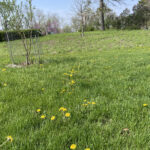
Mowing low encourages dandelions.
Observation reveals a dandelion secret. They thrive on mowed lawns and rarely grow in prairies, woods, or wetlands. Mowing invites dandelions to move in, and chemical companies are ready to sell potions designed to kill a plant with a remarkable relationship with people. A natural way to reduce dandelion numbers in a lawn is simply to set the mower to cut at its highest level. It leaves the grass a big shaggy but their leaves shade the ground and discourage dandelion growth.
We enjoy dandelions at Winding Pathways and steam young tender leaves every spring.
by Winding Pathways | Apr 28, 2022 | (Sub)Urban Homesteading, Chickens, Foraging, Garden/Yard, Garden/Yard, Weeds
We are shocked by the rise of many prices, especially food. Fortunately, we mute the cost by finding or growing groceries here at Winding Pathways. We’re lucky to own two acres, but folks living on tiny lots can produce an amazing amount of food, even if they aren’t passionate gardeners.
In a nutshell here’s what we do to tame grocery bills:
Foraging
It’s ironic that many people consider the most delicious and easy wild foods pests and spend time and money trying to eliminate them. We eat ‘em. Books and websites, including Winding Pathways, share tips on finding, identifying, harvesting, cooking, and eating wild foods. Caveat: ALWAYS check that you have the correct plant, gather from unpolluted places, and consume only a small amount initially to be sure your body accepts the wild edible.
Here are our favorites:
Gardening
We’re not passionate gardeners and we don’t can or freeze vegetables, so here’s what we do:
- Succession plant: Our small garden yields an enormous amount of food. We don’t let a square foot be idle. When summer’s heat turns lettuce bitter, we pull it, feed it to our chickens, and plant beans or another heat-loving crop. Same with other crops that grow quickly and then fade.
- Use vertical space: Pole beans, for example, produce much more food per square foot than bush beans, so we choose climbers and use vertical space. We have the pole high enough to reach up and pull off the beans.
- Grow dwarfs: Some cucumber varieties, for example, are “bush” type, meaning they produce a crop without long vines that consume plenty of space.
- Think of winter eating: Because we lack freezer space and don’t can food, we plant vegetables that need little care during the growing season and store them until late winter without being canned or frozen. Here’s our list:
-
- Winter squash. Pick them, let them curet, and store them in a cool spot. They keep for months. Same with pie pumpkins.
- Carrots and parsnips. In late fall we smother the plants with a thick blanket of dry leaves or straw that keeps the ground from freezing. We’ve harvested carrots in January by brushing away snow and peeling back the mulch and pulling them.
- Sweet potatoes. They love the South’s climate yet grow well up north.
We carefully dig them in the fall, cure them, and store them like winter squash.
-
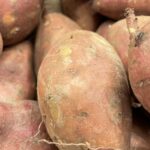
-
Sweet potatoes are a healthy vegetable.
-
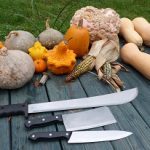
-
Winter Squash vary in color, texture, shape and size.
Chickens
We can’t imagine living without a small chicken flock. Our six to 12 hens gift us a couple of dozen eggs a week. Their manure fertilizes the garden and garden weeds are a great hen chow. During warm months our hens forage in their large run eating bugs, worms, and weeds and transforming them into eggs. Sometimes we even stew down an old hen.
-
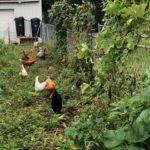
-
In the summer hens find plenty to eat.
-
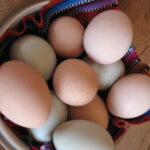
-
The chickens kept on laying eggs.
-
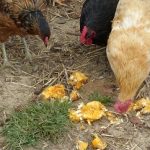
-
Chickens efficiently recycle squash seeds to eggs.
Wildlife
Lots of folks don’t like hunting. For us harvesting a deer is a form of food gathering, not recreation. After all, deer are free-ranging, local, and organic. Fortunately, we’re able to hunt on our property and convert a deer into delicious meat. We also enjoy eating panfish.
Like most folks, we can’t grow or forage all our food but much comes from the yard and area. It takes knowledge and investment in elbow grease but trims the food budget. Perhaps even better, knowing how to find and grow food makes us feel less vulnerable to national disruptions that make food either hard to get or expensive.
by Winding Pathways | Apr 7, 2022 | Foraging

Enjoying coffee and a latte.
Every spring we enjoy a cup of free coffee. In good years it’s coffee plus free lunch. Nope, the coffee shop doesn’t skip our bill. It’s free because we’d just left the Marion Iron Company with cold cash after selling a year’s accumulation of scrounged metal.
Recycling, as most people know, is relatively new, but scrap yards have been buying and recycling metal for centuries. Here’s what we do to earn a few bucks.
We scrounge free pallets from businesses that toss them in heaps to be hauled to the landfill. Our Milwaukee circular saw cuts them into chunks that make outstanding wood stove kindling and fuel for outdoor campfires. When the ashes have cooled, we run a magnet through them, retrieve the nails, and store them in old metal paint buckets.
Picking Up Metal
Whenever we spot a chunk of metal along the road or in a parking lot, we pick it up and add it to our scrap metal trove. In some years we’ll have a couple of hundred pounds of nails and random scrap to sell.
-

-
We add our metal to th3e pile.
-

-
Big claws grip metal.
-

-
This metal may have crossed the ocean many times.
We like selling scrap. It generates money but mostly just feels good to see our nails recycled. We envy them for their travels. Many nails are made in China and make the long journey across the ocean to eventually be used by pallet companies. We sell the reclaimed nails at the scrap yard. They ship them to a company near Chicago that melts them into solid blocks of steel. Those are bought by all sorts of companies that make thousands of products from them. So, our old nails may end up as a car, pocket knife, re-bar, or who knows what? They might even cross the ocean to be sold to a foreign steel manufacturer.
Like-Minded Friends
We recently learned we’re not alone. Friend, Kurt Rogahn, saves bits of aluminum. When a small pile accumulates off to recycling, they go.
We’re not getting rich selling metal. The price per pound at the scrap yard varies from year to year. If we have plenty to sell and if the price is high our old nails buy us an elegant lunch. In a poor year, it’s free coffee.
Scrap steel and iron usually bring the lowest price per pound. Aluminum, copper, and brass sell for much more.

Cold cash for scrap.
After writing the above we delivered our metal to Marion Iron. It weighed 80 pounds, and we left with $7.00! Minutes later we were at Mr. Beans Coffee shop just down the road. Our cold cash bought us coffee and a bit more.
Recycling is the right thing to do with a free coffee bonus.
by Winding Pathways | Dec 2, 2021 | (Sub)Urban Homesteading, Foraging, Garden/Yard, Trees
On a windy cold Thanksgiving afternoon, we did something nutty. After tossing buckets and shovels into our pickup we drove north until we spotted greenish foliage popping through the road ditches dry grass.
There, we rescued six red cedar trees that are now at home in our yard.
A Hardy Tree
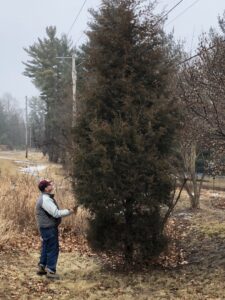 Few American trees have such a love-hate relationship with people as the red cedar, which is actually a Juniper. Perhaps it’s unpopular because of the plant’s amazing adaptability. Sure, it needs full sunlight but given that it thrives in heat, salty roadsides, and terrible soil it is one hardy plant! Even stiff grass competition that snuffs out other baby trees doesn’t seem to bother it.
Few American trees have such a love-hate relationship with people as the red cedar, which is actually a Juniper. Perhaps it’s unpopular because of the plant’s amazing adaptability. Sure, it needs full sunlight but given that it thrives in heat, salty roadsides, and terrible soil it is one hardy plant! Even stiff grass competition that snuffs out other baby trees doesn’t seem to bother it.
Red cedars thrive from the Great Plains eastward to the Atlantic Ocean. In many places they are small bushes, but sometimes the tree grows big enough to interest loggers. The aromatic wood is used to craft cedar chests, closet linings, and even pencils. Fence posts made of it last for decades.
Why Ranchers and Farmers Dislike Cedars
Ranchers curse cedars because they spread in pastures. Cattle don’t like dining on prickly cedar twigs, and within a decade or two cedars replace the grassy food that cows love with a green desert of scrubby trees.
What’s to Love About Red Cedars
But, a cedar grove isn’t really a desert. Birds, especially cedar waxwings, love eating their tiny blue berries, and dense stands of cedars protect many species of wildlife from howling wind, searing sun, and predators.
There’s more. We live in Cedar Rapids, a city named for the rugged trees that grow in rocky bluffs over the Red Cedar River. They’re small and twisted but some are over 400 years old.
We planted our cedars on the edge of our property where they will form a screen from the wind and passing car headlights. They also will give us privacy, and be a safe home for birds that visit our feeders.
In mid-December, we’ll return to the road ditch and cut a six-foot red cedar for our Christmas tree. Cedars are scraggly and unsymmetrical, but we don’t put our tree up in the house. It will grace the Holiday season on our back deck. Pouring a few cups of sunflower seeds in its foliage creates a living stream of ornaments as goldfinches, chickadees, cardinals, and nuthatches come and go.
For information on red cedars and many other trees visit the website of the National Arbor Day Foundation.
-
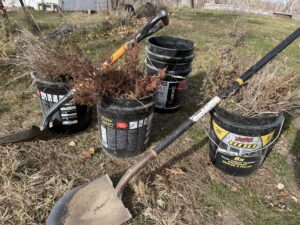
-
We rescued seedlings to plant for screens in our yard.
-

-
We remember to protect the seedlings.
by Winding Pathways | Jul 15, 2021 | (Sub)Urban Homesteading, Foraging, Nature
We take a walk every day, sometimes through urban and industrial areas. Other days find us on prairie or woodland trails. Everywhere we’re spotting an abundance of summer fruit being devoured by birds, woodchucks, chipmunks, and even deer.
Last August 10 a terrible derecho roared through our area, felling about 70% of mature trees. It seemed tragic but a year later vegetation has responded with enthusiasm in former shady places now sunlit. These include berries. Brambles: Newly sunny woods are filled with first-year black raspberry and blackberry canes. Next year there’ll be an abundance of berries. These are delicious food for people and wildlife. We like them fresh.
Here are few other species of berries. Some are human edibles. Others leave for the birds.
Munching

The sweet, but bland mulberries are children’s favorite.
Mulberries: These deliciously sweet, but bland, fruits have a long bearing season that’s mostly in June but lingers well into July. Robins just love them. So do many other birds……and children. Mulberries are a delicious underused human food. One of our favorite dishes is rhubarb mulberry pie.
Cherries: Many birds love domestic cherries. Our trees were almost ready to pick when a family of raccoons did the picking for us. No cherry pies this year. Wild black cherries are common. They’re edible to humans but are small, have a big pit, and are usually bitter. They’re hardly worth the effort to pick and process so we leave them for the birds to enjoy.
Leave These for the Wildlife
Chokecherries: They ripen in late June and into July. These pucker up any human trying to eat them, but birds love snacking on them.
Elderberries: These shrubs love trail and roadside sun and produce bunches of berries in late summer and into fall. Some people go to the trouble of making wine or jam from them but we leave them for the birds to enjoy.
Poison Ivy: Another berry to leave to the birds is poison ivy. This favorite of birds is how the plant spreads when the birds drop seeds. Leaves of three? Let them be!
-
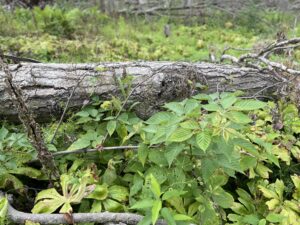
-
Berry canes emerge in the sun.
-
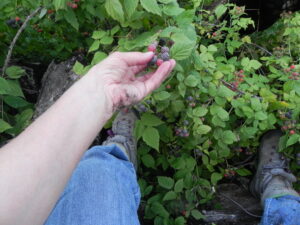
-
We bring along a small bag to bring home berries.
-
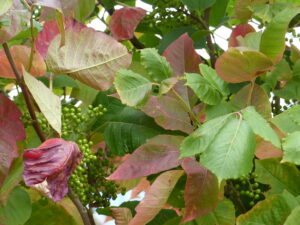
-
Birds spread poison ivy by eating the berries and pooping the seeds out later.
Dogwoods: These berries aren’t human food but make delicious bird chow. They ripen late and stay on the shrub through winter. Want to find bluebirds or robins on a cold January day? Find a patch of dogwoods that still have frozen berries clinging to them.
Winter Food

Waxwings flock to winter berries.
Highbush Cranberries: Look from late July on as they ripen in mid to late summer. A wildlife favorite, birds and chipmunks forage happily in the shrubs. Some berries linger into winter and often wintering waxwings greedily forage on the berries. Deer come by and munch both the leaves and berries.
When we set off on a summer walk, we stuff a bag or two into our pockets. Then, if we discover a blackberry patch, we’ve got a way to carry a few handfuls home.











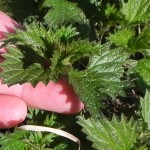
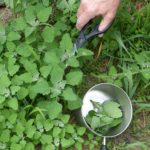
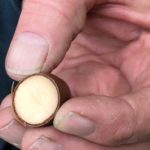











 Few American trees have such a love-hate relationship with people as the red cedar, which is actually a Juniper. Perhaps it’s unpopular because of the plant’s amazing adaptability. Sure, it needs full sunlight but given that it thrives in heat, salty roadsides, and terrible soil it is one hardy plant! Even stiff grass competition that snuffs out other baby trees doesn’t seem to bother it.
Few American trees have such a love-hate relationship with people as the red cedar, which is actually a Juniper. Perhaps it’s unpopular because of the plant’s amazing adaptability. Sure, it needs full sunlight but given that it thrives in heat, salty roadsides, and terrible soil it is one hardy plant! Even stiff grass competition that snuffs out other baby trees doesn’t seem to bother it.





